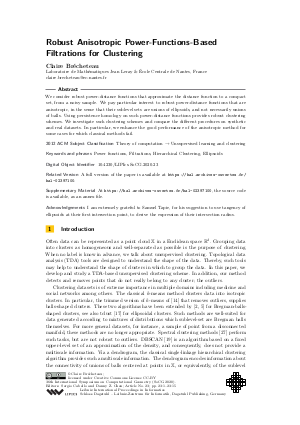@InProceedings{brecheteau:LIPIcs.SoCG.2020.23,
author = {Br\'{e}cheteau, Claire},
title = {{Robust Anisotropic Power-Functions-Based Filtrations for Clustering}},
booktitle = {36th International Symposium on Computational Geometry (SoCG 2020)},
pages = {23:1--23:15},
series = {Leibniz International Proceedings in Informatics (LIPIcs)},
ISBN = {978-3-95977-143-6},
ISSN = {1868-8969},
year = {2020},
volume = {164},
editor = {Cabello, Sergio and Chen, Danny Z.},
publisher = {Schloss Dagstuhl -- Leibniz-Zentrum f{\"u}r Informatik},
address = {Dagstuhl, Germany},
URL = {https://drops.dagstuhl.de/entities/document/10.4230/LIPIcs.SoCG.2020.23},
URN = {urn:nbn:de:0030-drops-121818},
doi = {10.4230/LIPIcs.SoCG.2020.23},
annote = {Keywords: Power functions, Filtrations, Hierarchical Clustering, Ellipsoids}
}

 Creative Commons Attribution 3.0 Unported license
Creative Commons Attribution 3.0 Unported license









